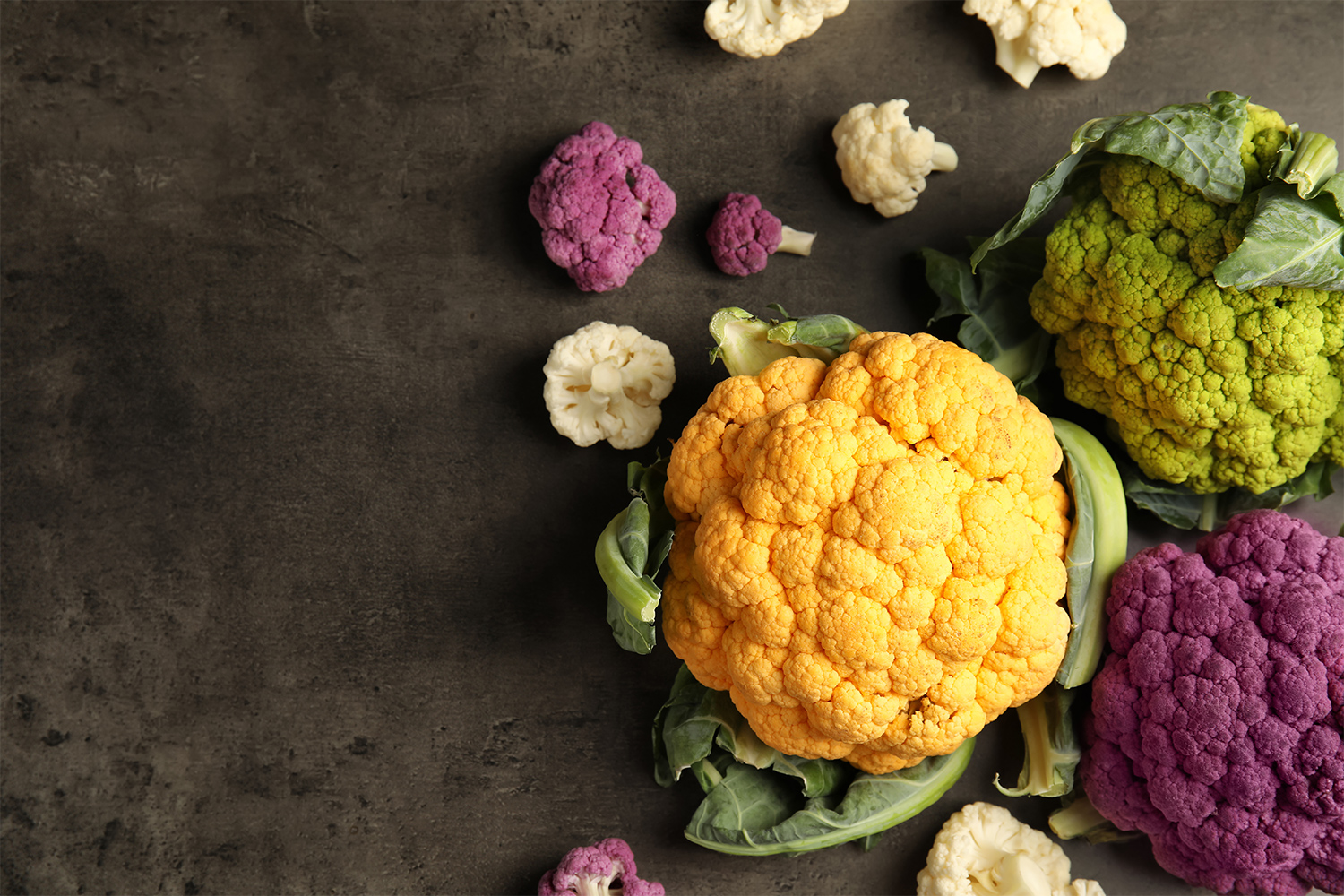In the Keto war against carbohydrate-laden starches, the Paleo aversion to grains and the allergy front against gluten, there stands a surprising beneficiary: cauliflower. Or maybe I should say cauliflower farmers and creative chefs? Over the last few years cauliflower has popped up in everything from pizza crust to mac n’ cheese. It’s even replaced beef in sloppy Joes and chicken in buffalo ‘wings’ for vegetarian recipes. Wonder why this unassuming vegetable is now the hottest replacement for wheat flour, potato and meat?

It’s not just because of cauliflower’s sturdy texture, mild taste and low carbohydrate content (5 grams per cup*). Cauliflower boasts a high amount of Vitamin C, is a good source of folate and vitamin B6, and also provides vitamin K and fiber.1, 2 Its beneficial phytochemicals include carotenoids, glucosinolates, isothiocyanates and indoles.2,3,4 Cauliflower is a member of the cruciferous family of vegetables (Brassica genus) known for their anti-cancer properties,3 specifically in colon and prostate cancer prevention.5 Regularly consuming at least one cup of cruciferous vegetables daily is also shown to benefit cardiovascular health.6
Okay, so cauliflower is good for you – no surprise there. Incorporating this versatile vegetable into your regular fare doesn’t take magic, just a little imagination and perhaps practice.
Here are 12 clever ways to work cauliflower into your kitchen repertoire:


- Dice or slice raw for salads.
- Bake into a sweet breakfast bowl like quinoa with apples and cinnamon.
- Steam then blend with stronger ingredients (like pesto, garlic or herbs) to absorb their flavor.
- Cut and cook in tomato soup with basil and paprika.
- Use riced in place of fried rice in Asian dishes.
- Bake into savory Southwestern style casseroles with cumin, chili powder and pepper.
- Chop and sauté with chickpeas, turmeric and sweet potato.
- Use riced in place of grits.
- Roast to intensify its natural flavors through caramelization. First drizzle with olive oil and a pinch of seasoning (pepper, garlic powder, onion powder or red pepper flakes).
- Mash cauliflower to substitute for spuds. Just add salt, garlic, butter, sour cream or chives for flavor.
- Make cauliflower dough for pizza crust, tortillas, etc. To pureed, pressed cauliflower you’ll need to add a few other ingredients to hold the dough’s consistency together, such as egg or xanthan gum.
- Replace potato in holiday latkes.

Did you know? Cauliflower is readily available in cooler weather making it a seasonal and sustainable produce purchase. Called a curd, the head of cauliflower holds hundreds of immature florets attached to a single stem. Though typically white, cauliflower is also found in orange and purple varieties as well as a chartreuse Romanesco cauliflower.

Keep in mind that just because a product contains cauliflower doesn’t make it healthy – plenty of cauliflower foods and recipes abound with exorbitant fat, sugar or sodium! Here’s one that fits healthy checklists from Chef Rocco DiSpirito’s 2017 cookbook, Rocco’s Healthy + Delicious:
RAW CURRY RAGOUT WITH DICED ZUCCHINI (serves 4)
INGREDIENTS
- 1 head cauliflower
- 1 tablespoon extra-virgin olive oil
- 2 teaspoons curry powder
- ½ cup unsweetened coconut milk beverage
- Salt and pepper
- 1 large zucchini, diced
METHOD
- Shave the cauliflower on the large holes of a box grater to make “rice.”
- Transfer to a large bowl and combine with the olive oil, curry powder, and coconut milk.
- Season with salt and pepper.
- Transfer to a serving dish and top with the diced zucchini.
NUTRITION, per serving
- 94 Calories
- 5 g fat
- 4 g protein
- 3 g carbohydrate
- 5 g fiber
*Nutrient value from USDA’s FoodData Central. Findings were used along with RDN’s professional judgment.
References
- Linda Carruthers. “Cauliflower: The New Nutrition Superstar.” https://mayoclinichealthsystem.org/hometown-health/speaking-of-health/cauliflower-the-new-nutrition-superstar February 27, 2018. Accessed 11.5.2019
- Berkeley Wellness. “Cauliflower: Nutrition Best Served Raw.“ https://www.berkeleywellness.com/healthy-eating/food/article/cauliflower-nutrition-best-served-raw September 28, 2015. Accessed 11.5.2019
- Chen L, Cheng PH, Rao XM, et al. Indole-3-carbinol (I3C) increases apoptosis, represses growth of cancer cells, and enhances adenovirus-mediated oncolysis. Cancer Biology and Therapy. Sept 2014;15(9):1256-1267.
- Erica Ilton. “Catch the Cauliflower Craze.”https://www.berkeleywellness.com/healthy-eating/food/article/catch-cauliflower-craze July 31, 2018. Accessed 11.5.2019
- Densie Webb. Powerful Prostate Cancer Fighters — From Arugula to Wasabi, Cruciferous Veggies Pack a Powerful Punch. Today’s Dietitian October 2011; 13(10): 20.
- Lauren Blekkenhorst et al. Cardiovascular Health Benefits of Specific Vegetable Types: A Narrative Review. Nutrients, 2018 May; 10(5): 595. Published online 2018 May 11. doi: 10.3390/nu10050595









Keep up the good work! You know, many people are looking around for this information online, you could help them greatly.